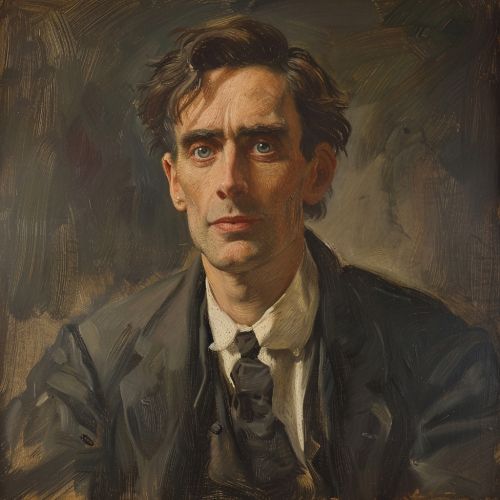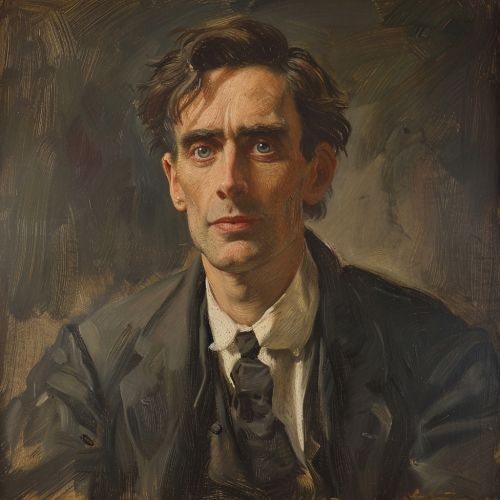William Hope Hodgson
Early Life and Background
William Hope Hodgson was born on November 15, 1877, in Blackmore End, Essex, England. He was the second of twelve children born to Samuel Hodgson, an Anglican priest, and Lissie Sarah Brown. The family moved frequently due to Samuel’s clerical assignments, which exposed Hodgson to various locales across England and Ireland during his formative years. This itinerant lifestyle contributed to Hodgson's later fascination with the sea and the supernatural.
Maritime Career
At the age of thirteen, Hodgson ran away from boarding school to become a sailor. His parents eventually consented, and he was apprenticed to the Merchant Marine. Hodgson's maritime career spanned from 1891 to 1899, during which he rose to the rank of third mate. His experiences at sea profoundly influenced his later literary works, providing a wealth of material for his sea tales and horror stories.
During his seafaring years, Hodgson became an accomplished photographer, capturing images of life at sea. He also developed a keen interest in physical fitness, which led him to open a gymnasium in Blackburn, Lancashire, after leaving the Merchant Marine. His dedication to fitness and bodybuilding was notable, and he even won a medal for bravery in 1898 for rescuing a fellow sailor.
Literary Career
Early Works
Hodgson began his literary career in the early 1900s, initially focusing on poetry and short stories. His first published work, "The Goddess of Death," appeared in 1904 in the magazine "The Royal Magazine." This was followed by a series of short stories and poems published in various periodicals, establishing Hodgson as a promising new voice in speculative fiction.
Novels
Hodgson's first novel, "The Boats of the 'Glen Carrig'," was published in 1907. This work is a classic example of his unique blend of nautical adventure and supernatural horror. The novel recounts the harrowing journey of the survivors of a shipwreck as they navigate through a series of bizarre and terrifying encounters.


In 1908, Hodgson published "The House on the Borderland," which is considered one of his most significant works. This novel is a complex narrative that combines elements of horror, science fiction, and fantasy. It tells the story of a recluse who discovers a manuscript detailing his experiences in a mysterious house that serves as a gateway to other dimensions.
"The Ghost Pirates," published in 1909, is another notable work that showcases Hodgson's maritime background. The novel describes the eerie and supernatural events that befall the crew of a doomed ship. Hodgson's detailed knowledge of seafaring life lends authenticity to the narrative, enhancing the sense of dread and suspense.
Hodgson's final novel, "The Night Land," was published in 1912. This ambitious work is set in a distant future where the sun has died, and humanity survives in a massive pyramid-like structure known as the Last Redoubt. The novel's dense and archaic prose style has divided critics, but it remains a seminal work in the genre of weird fiction.
Short Stories
Hodgson was also a prolific writer of short stories, many of which were published in magazines such as "The Strand Magazine" and "The Idler." His short fiction often explored themes of the supernatural, the unknown, and the macabre. Notable short stories include "The Voice in the Night," "The Derelict," and "The Sea Horses."
One of Hodgson's most enduring creations is the character of Carnacki the Ghost-Finder, who appeared in a series of short stories published between 1910 and 1912. Carnacki is a detective who specializes in investigating and combating supernatural phenomena. The stories blend elements of detective fiction and horror, and they have been influential in the development of the occult detective subgenre.
Themes and Style
Hodgson's works are characterized by their unique blend of horror, science fiction, and fantasy. His maritime background is a recurring theme, with many of his stories set at sea or involving nautical elements. Hodgson's writing often explores the boundaries between the known and the unknown, the natural and the supernatural.
A key theme in Hodgson's work is the insignificance of humanity in the face of vast, indifferent cosmic forces. This is particularly evident in "The House on the Borderland" and "The Night Land," where characters confront entities and phenomena beyond human comprehension. Hodgson's portrayal of the sea as a mysterious and hostile environment also reflects this theme.
Hodgson's style is marked by its vivid and evocative descriptions, which create a strong sense of atmosphere and tension. His use of archaic language and complex narrative structures can be challenging for readers, but it also contributes to the otherworldly quality of his work.
Personal Life
Hodgson married Bessie Farnworth in 1913, and the couple settled in the village of Borth in Wales. Despite his literary success, Hodgson continued to struggle financially, and he supplemented his income by giving lectures on physical fitness and the supernatural.
With the outbreak of World War I, Hodgson enlisted in the British Army. He was commissioned as a lieutenant in the Royal Artillery and served with distinction. Tragically, Hodgson was killed in action on April 19, 1918, during the Fourth Battle of Ypres. He was 40 years old.
Legacy
William Hope Hodgson's work has had a lasting impact on the genres of horror, science fiction, and fantasy. His innovative blending of these genres and his exploration of cosmic horror have influenced numerous writers, including H.P. Lovecraft, who praised Hodgson's work in his essay "Supernatural Horror in Literature."
Hodgson's novels and short stories continue to be read and studied, and they have been reprinted in numerous editions. His creation of Carnacki the Ghost-Finder has inspired other writers to develop similar occult detective characters, and his influence can be seen in the works of contemporary authors such as China Miéville and Ramsey Campbell.
